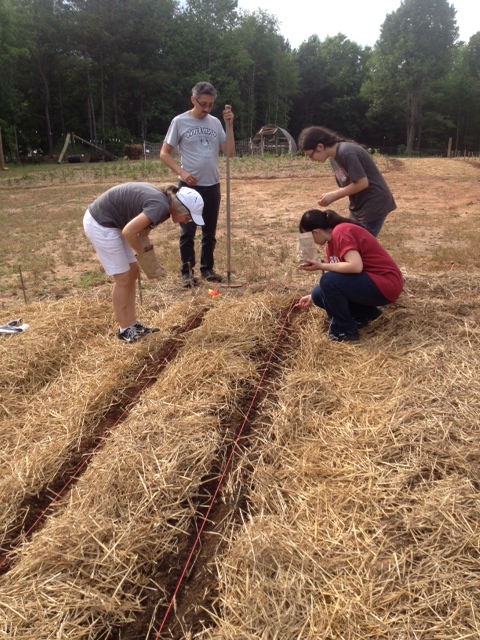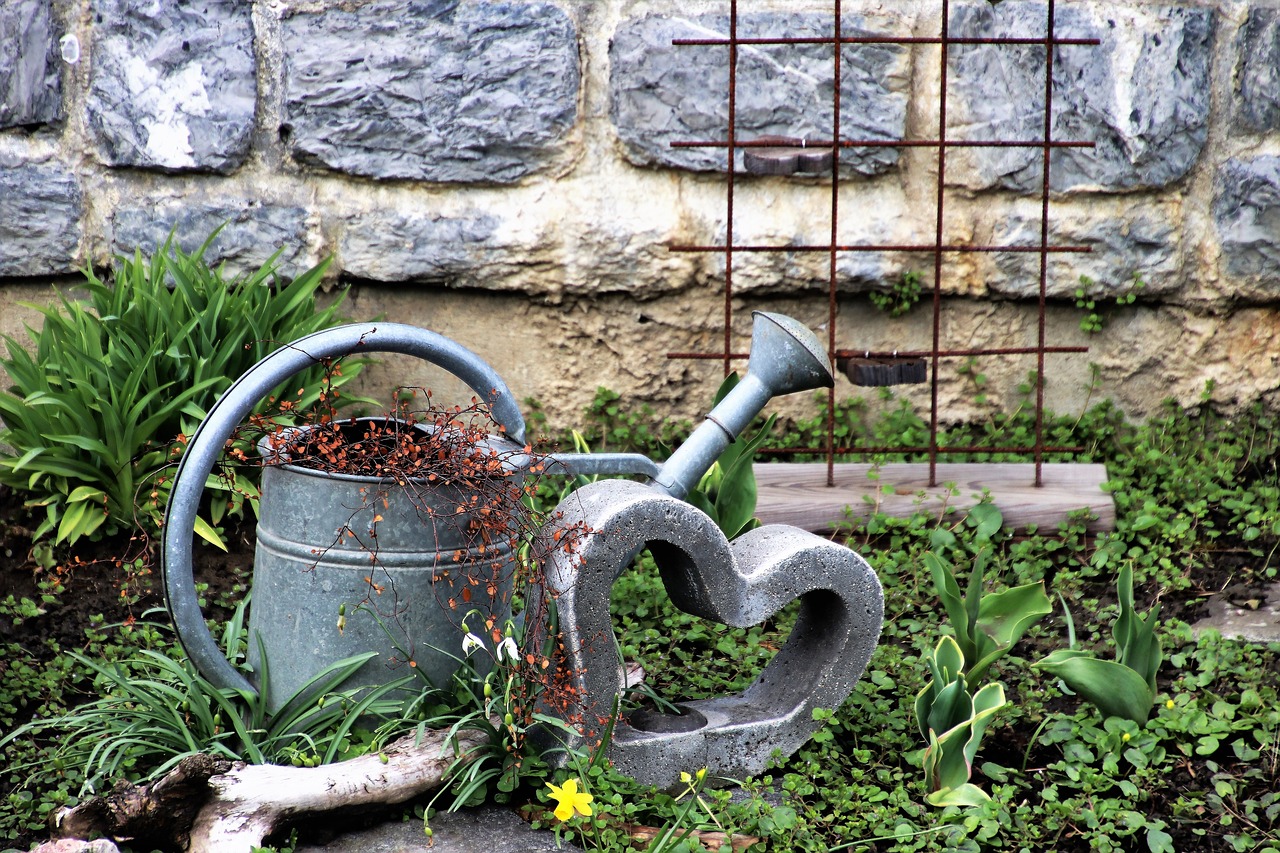Simple Low-Till Planting Techniques
In this post I am going to share some tips on planting your garden without pulverizing the whole thing into a ‘seedbed’ first. As I seek to look at the wisdom in God’s Creation and utilize it on my farm, the two principles I seek to apply in my garden are:
- No deep plowing.
- Keep a mulch on the ground.
When I share with others how I manage my garden one of the questions that come up is: “How do you plant in an unplowed garden?”
Learning Curve
For most gardeners, preparing the garden for planting involves using a tiller or tractor to ‘work’ the soil into a fine tilth so they can easily lay off rows for planting seeds or setting out plants. This is what I did for many years. It was so satisfying to see the soft soil, smell it’s richness, and create a garden masterpiece on that beautiful dirt canvas. But after seeing my dream quickly turn into a nightmare of compacted soil and erosion after the first few rains each season, I began trying to learn about stewarding the soil in a way consistent with God’s design. Romans 1:20 says, “For since the creation of the world God’s invisible qualities – his eternal power and divine nature – have been clearly see, being understood from what has been made, so that men are without excuse.” Looking for God’s wisdom in his creation led me to begin applying the two principles I mentioned above: Minimal soil disturbance and using mulch. But now planting became a challenge, for I now longer had a blank slate of loose soil into which my seeds and plants could nestle. So how was I supposed to plant into an unplowed garden?
The Simplicity of God’s Planting System
The beauty of farming for God is that we have a very simple solution every time we face a problem. All we have to do is ask the Master Farmer for wisdom! James 1:5 tells us that if any of us lacks wisdom we should ask God and he will give it to us if we ask without doubting. Do you really believe that God can give you wisdom even in planting your garden? One of the ways that God can share wisdom with us is through his creation. In the Gospel of John chapter 5 verse 19 we read that Jesus only did what he saw the Father doing. So in regards to planting what do we see our Father doing in his marvelous creation?
Simply put, the simplicity of God’s planting method is seed-to-soil contact. When a seed falls on the blanket of mulch that God has covering the ground, it will sit there. But as soon as something causes some disturbance that bring the seed into contact with the soil, i.e. a bird scratches in the leaves, a deer or other animal scratches the surface with their hooves or a storm washes the seed down through the mulch, then that seed will begin to sprout and grow! No deep plowing, no special planting device needed.
So in my garden I have tried to learn from what my Father does, and use a simple planting system that utilizes the seed-to-soil contact principle. Let’s take a look at how it works so you can do it yourself!
A Low-tech Planting Toolkit
I use only a few, low-tech tools for most of my planting. Here are the materials you need:
- Tape Measure: For measuring the spacing of your rows and plants “And I lifted my eyes and saw, and behold, a man with a measuring line in his hand!” Ezekiel 2:1
- String: For keeping everything nice and straight.
- Stakes: For marking off the ends of your rows.
- Digging Tool: For making your planting holes and furrows.
- Options:
- Hoe
- Soil Knife
- Planting Stick
- Options:
Planting Step-by-Step
- Remove the Existing Plants, Old Crops/Weeds without Plowing! The first thing you need to do before planting the plants you want is to remove the plants you don’t want! And this is the part where is seems like your plow or tiller would come in handy. But wait! Step down off that tractor and consider a few other options first.
- Option 1: Hoe weeds off at ground level. This may sound hard, but it really isn’t. Especially when compared to techniques like double-digging! All you need to do is use a heavy hoe to cut off whatever plants there are right at or below ground level. Not digging. Just cutting off the plants at the roots. This is one of the fastest ways of ‘eating the elephant’. Just mark off a small section of your garden and complete it before taking another bite. This method is best for new garden plots. (Tip: Use a heavy hoe like a Rogue Hoe rather than a light cultivating hoe.)
- Option 2: Pull Weeds/old crop by hand. Again, this may sound hard but it really can be one of the quickest ways to clean up a bed for planting. I just cleared an old crop of green out of a bed yesterday this way. I had a bucket next to me and just ripped out the old plants fast as I could go leaving as much of the roots in the ground as possible and threw them in the bucket. The bucket contents then went in with the chickens who are cleaning up the part of the garden that is resting this year. This method is better than hoeing for established beds.
- Option 3: Smother weeds with a tarp. If you think ahead and have the time this is the way to go! I know you have seen how the grass dies when you accidentally leave something in the yard for too long. Same thing will happen with the grass and weeds where you garden goes! You can use a tarp or any type of UV resistant plastic. You could also use sheets of metal or any other material that is available and easy to handle. I like using pieces of silage tarp that I cut to the size of my garden plots.
- Add Mulch if Needed
- Make sure your garden is covered with mulch. Not too deep, just try to mimic the amount you see in the woods.
- For my planting areas I like to use mulch from leaves or grass. Sometime I also use compost as well.
- For paths I like to use bark mulch when available.
- Water if Necessary
In order to soften the soil of an unplowed garden it needs to be moistened if it is dry. Undisturbed soil is similar to a sponge in that it is hard when dry (to protect it from washing away) and soft when moist. Again, make sure you have some type of light mulch cover on the surface of the ground when watering to soften the impact of the water and prevent compacting the soil. - Layout Your Row Spacing Using a GPS System
- For laying out my row spacing I use a ‘GPS’ system. But not the high tech one you might be thinking of. In my system GPS stands for ‘Gently Pull the String’!
- Determine the proper row spacing for the crops you are planting. You can use a planting chart to give you specific but in general you need to take into consideration 2 things:
- How much room will your plants need when they reach maturity?
- How much room do you need in order to access and manage them?
- Use you measuring tape to place stakes at either end of your rows.
- Then ‘gently pull the string’ tightly between the stakes to mark where your rows will be.
- Pull Back Mulch
- In order to disturb the soil where we are going to plant we need to first pull back the mulch to keep it from getting in the way or getting buried.
- If we are planting a solid row, like beans or turnips, then we will rake back the mulch along the whole row.
- If we are planting in holes, like with tomatoes, then we can rake back the mulch only where the plants will go.
- If we are planting a solid bed densely with greens then we may remove mulch temporarily from the whole bed.
- Minimally Disturb Soil
- After removing the mulch we then will dig holes or furrows where our plants will go. You can use a hoe, soil knife, planting stick, or any other pointed tool.
- If our soil was properly moistened the ground should be easy to dig in.
- Only disturb the soil where you will be planting.
- Add Amendments
- Before planting add any soil amendments in your planting furrow or hole.
- For example: Compost, lime, minerals, (chemical fertilizers can be used if nothing else is available but are not recommended long term).
- Cover your amendments with a little soil, leaving the hole or furrow deep enough to plant your seeds or seedlings.
- Before planting add any soil amendments in your planting furrow or hole.
- Plant Seeds/Plants and Cover
- Place your seeds or seedlings precisely in your furrow or holes. PLACE them, don’t just throw them. Accuracy and high standards in the little things can make a big difference in yield at the end.
- Carefully cover your seeds or bury the base of your seedlings with loose soil.
- Seeds should generally be buried 2-3 times the diameter of the seed.
- Most seedlings should be covered so the base of the stem is level with the ground. (However, tomatoes can root from the stem and like to be buried deep)
- Mulch and Water
- After planting add mulch.
- For seeds cover with a very light mulch only about 50% coverage. Grass clipping are a good option for this.
- For seedlings pull mulch back around the base of the plant.
- Water through the mulch for excellent penetration and saturation of the soil.
- After planting add mulch.
The Most Important Part of Planting
Now your garden is planted! However, you still have the most important step to do. Pray! 1 Corinthians 3:7 says “So neither he who plants nor he who waters is anything, but only God, who makes things grow.” We must do our best, but we are ultimately dependent on God and need to ask him to bless our garden and give us wisdom to care for it.
I hope this gives you a better idea of how to plant in an unplowed garden! To get you started I have created a free No-Till Planting Checklist to help you next time you are planting something in your garden. You can download it below.
Let me know if you have any questions or comments!
Get our Free No-Till Planting Checklist!
Use our step-by-step checklist to help you when planting your garden.



Great! and I appreciate the details. A covering is so vital to gardening. Just remember the dust bowl. All covering had been removed large scale, for agriculture. Somehow, when things are enlarged (no longer family gardening or family farmers) and leave the personal and manageable touch, the details get twisted/lost. Thanks for keeping God in the method. All His ways are the best!
Excellent comment! This is what I was trying to work though in my mind. My grandmother, a very devoted Christian woman, always gardened in a tiny backyard, but had plenty! She canned, and cooked fresh for a huge extended family. Her methods were Biblical, but not what is typically seen in the world of industry. 🙂
Thanks!
Very helpful information, thank you!
How to you incorporate larger amounts of soil amendments, such as manure with this method (ie not just in the planting furrow)- or is that not necessary with this method?
yes powerful and inspired. Thank you for these sustainable ways of ‘farming the God’s way’. one thing l kindly ask from you is that you shoot videos as you will be explaining
What a beautiful article! Thanks!
Thanks for making so much information so easy to access for everyone!